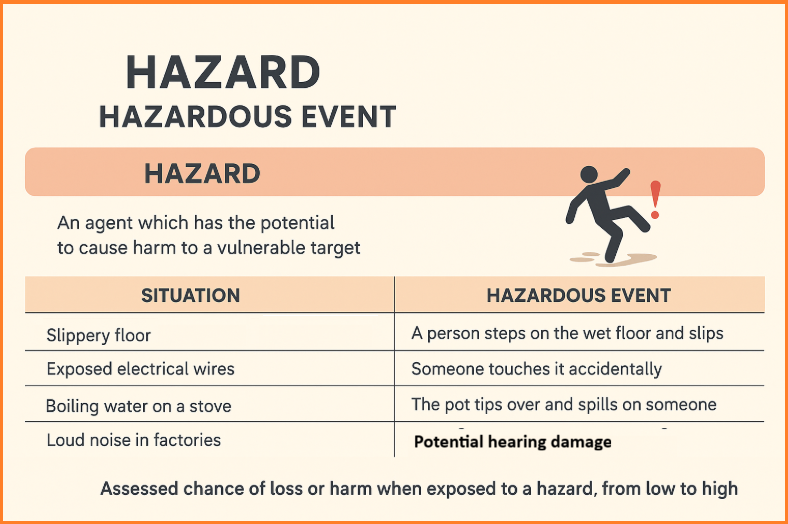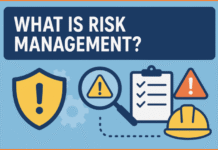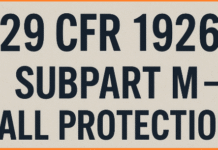In our daily lives, whether at home, on the road, or at work, we are constantly surrounded by things that could harm us if not handled properly. In safety management, three important terms help us understand and manage such situations: Hazard, Hazardous Event, and Risk. Though they may sound similar, each has a specific meaning. Let’s break them down with real-life examples so it’s easy to remember.
Contents
What is a Hazard?
A hazard is anything that has the potential to cause harm to a vulnerable person, object, or environment.
It could be a physical object, a chemical substance, a condition, or even a human action.
Examples of Hazards:
| Situation | Hazard |
|---|---|
| Boiling water on a stove | High temperature that can cause burns |
| Exposed electrical wires | Electric shock potential |
| Slippery floor | Chances of slipping and falling |
| Loud noise in factories | Potential hearing damage |
A hazard itself does not cause harm unless someone or something is exposed to it. It’s like a loaded gun kept on a table – dangerous, but it won’t hurt anyone until a certain action takes place.
What is a Hazardous Event?
A hazardous event is the actual occurrence or situation in which the hazard interacts with a target and has the potential to cause harm.
In simple words, it’s the moment when the hazard becomes active.
Examples of Hazardous Events:
| Hazard | Hazardous Event |
|---|---|
| Slippery floor | A person steps on the wet floor and slips |
| Exposed wire | Someone touches it accidentally |
| Boiling water | The pot tips over and spills on someone |
| Sharp knife | Hand gets too close while cutting |
The hazardous event is the trigger that causes the danger to materialize.
What is Risk?
Risk is the assessed chance (likelihood) of harm or loss occurring when someone is exposed to a hazard. It can range from low to high depending on factors like frequency of exposure, severity of impact, and control measures.
Risk = Probability of Harm × Severity of Outcome
Let’s take an example with a simple scenario:
| Scenario | Hazard | Hazardous Event | Risk Level |
|---|---|---|---|
| Water spilled in an empty hallway | Wet floor | Someone slips | Low (if few people walk there) |
| Water spilled in a busy cafeteria | Wet floor | Many people walking over it | High (more chances of slipping and injury) |
So, risk is not just about the existence of a hazard, but how likely it is to cause harm in a given situation.
Why Understanding These Terms Matters
Recognizing the difference between hazard, hazardous event, and risk helps in proper safety planning:
| Step | Purpose | Action |
|---|---|---|
| Identify Hazard | What can go wrong? | Spot all potential dangers |
| Analyze Hazardous Event | How can it go wrong? | Study unsafe situations |
| Assess Risk | How bad can it be? | Decide if intervention is needed |
| Control | How to prevent? | Remove or reduce risk |
Final Thoughts
- Hazard = Potential danger
- Hazardous Event = When that danger is activated
- Risk = How likely and how severe the harm could be
By understanding these simple concepts, we become more cautious, responsible, and better prepared to prevent accidents.. whether at home, at the workplace, or in any environment.
What is your thoughts? Write in the comment section, please..





